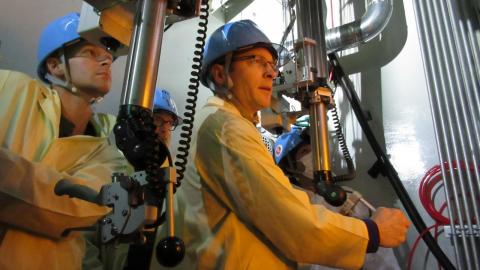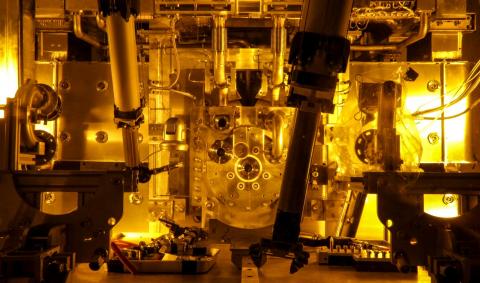

In the fall of 2015, TRIUMF remote handling received an urgent, long-distance call from the 2016 Breakthrough Prize-winning T2K experiment at the J-PARC facility in Tokai, Japan. T2K’s beamline was down after an unexpected problem in a highly radioactive area and the critical restoration was proving quite complex. The Japanese team reached out to their colleagues at TRIUMF hoping that the Canadian national laboratory would have the expertise required to complete the repair.
There was a lot riding on this repair operation. As Taku Ishida, a member of the T2K team working at J-PARC, explains, “the failure had impact for T2K to lose its position as the world-leading experiment in neutrino oscillation physics.” The T2K collaboration consists of over 400 physicists from 59 institutions in 11 countries, all clamoring for experimental data.
At J-PARC, protons zip through beamlines and into a graphite target to produce neutrinos for the T2K experiment. The proton interactions in the target produce heat, which is removed using a closed-loop helium-gas cooling system. And now this system unexpectedly sprung a leak. Fortunately, the T2K team quickly located the leak. It was contained at the outlet of the helium gas tube (“U-tube”) and did not damage the main target body. There was no leakage of radiated material since the target system is enclosed in a large helium vessel.
Nevertheless, it was still critical for the T2K team to repair this leaking U-tube to guarantee enough cooling capacity for forthcoming operations. But how?
The T2K team faced a critical challenge: due to beam-induced nuclear interactions, the target system became highly radioactive. This meant that staff could not touch or access the U-tube, not even while wearing protective gear. While the team did not anticipate the leak itself, they did anticipate that highly radioactive target system would require maintenance work. So, at an earlier date, TRIUMF built a hot cell with a set of remote handling manipulators for maintenance work at J-PARC. The leak was the first occasion for the collaboration to use the hot cell but they realized they needed help from remote handling experts. That is when TRIUMF’s Chad Fisher and Isaac Earle got the call.
Chad and Isaac are members of the Remote Handling Group at TRIUMF. “So what remote handling does is remove that hands-on access requirement, and do things either through robotics or a mixture of robotics and automation to achieve the desired result without getting dosed with radiation," explains Chad. (See video below.) Chad works primarily with the ISAC hot cell, whereas Isaac currently works on a control system upgrade for the Beamline 1A targets. There is no such thing as a typical day at the laboratory for these two. At any given time, you can find them working on various engineering projects, designing equipment, performing module maintenance, or tackling other critical tasks that keep TRIUMF at the top of its game.
When the two received word in October 2015 that a repair mission to T2K would be in their near future, they sprang into action eager to lend their expertise to their colleagues across the Pacific. Not only did Chad and Isaac offer their specialized expertise and technical know-how required for the challenging repair, but Chad in particular had the advantage of already being familiar with the facility – he had been to J-PARC and the T2K experiment on three separate occasions to set up their hot cell.
Colleagues from the United Kingdom’s Rutherford Appleton Laboratory (RAL) – members of the international T2K collaboration – were developing replacement U-tube and target equipment. J-PARC, RAL, and TRIUMF teams connected over numerous phone meetings to deconstruct the issue, discuss options for repair, and finally craft an ultra-detailed plan, complete with specifying every tool for each step of the operation. The teams also considered all the possible things that could go wrong and, more importantly, how to resolve them if needed. They knew they would have to be ready for anything.
Remote handling would be an essential component to the repair mission. “A lot of the objects with close proximity to the proton beam are highly radioactive,” explains Chad.
The next step involved the TRIUMF and RAL teams meeting their colleagues on-site at J-PARC. Following months of careful planning, Chad and Isaac were ready in December for a two-week trip to J-PARC.
The pressure didn’t let up.
After a week of rehearsals on a mock-up system, they only had one chance to replace the U-tube. The team was able to evaluate the new equipment designed by the RAL team, but there were other complications. For example, a beam monitor – built by the T2K groups at York University and the University of Toronto (both TRIUMF member universities) – had to be moved out of the way for the repair, and replaced afterwards, using the remote handling manipulators. Experts from the monitor system were on hand to provide help for this job. There were some additional minor issues – like a not-so-obviously reverse-threaded bolt – but overall, the preparation paid off and the mission went smoothly.
Chad and Isaac successfully replaced the pipe with their remote handling skills. Taku was “amazed how intricately the manipulators were controlled by Chad and Isaac; as two creatures loving to repair!”
Having successfully contributed to the repair mission, Chad and Isaac recorded the detailed procedures for future reference. The T2K team restored beam function at the end of January 2016 and is now continuing to accumulate precious neutrino event data. Within a few years, the neutrino production target material will have to be replaced in the remote maintenance hot cell. Chad and Isaac will be happy to assist with the T2K project again when their services are needed in the future.
-by Justina Bagger, guest writer
